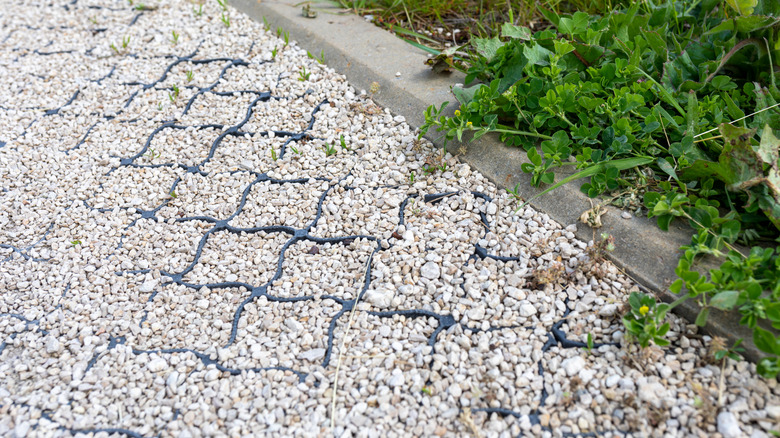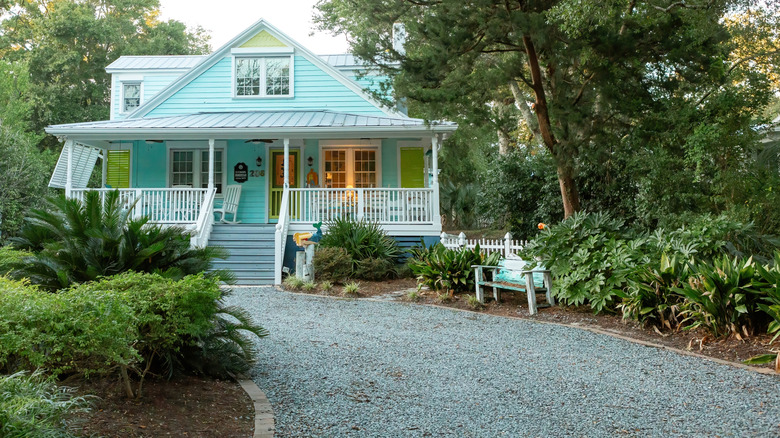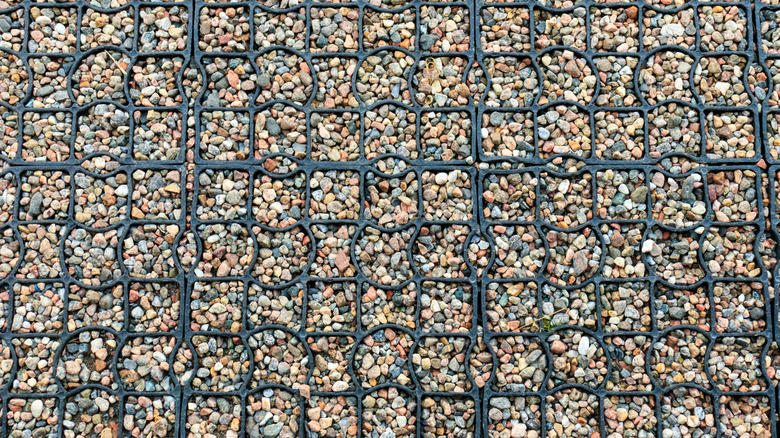Here's When It's Worth Using A Gravel Grid For Your Landscaping Project
We may receive a commission on purchases made from links.
Gravel grids, also called plastic permeable pavers, are designed to effectively keep gravel in place on driveways and paths. They are both durable and tough. Strong enough, in fact, to support weights of hundreds of thousands of pounds and be used for commercial parking lots.
However, there are benefits and drawbacks to using gravel grid systems. First, it's worth taking a quick look at how gravel grids are installed. It's not usually just a question of laying them on the ground and filling the pockets with gravel. They typically have a depth of a couple of inches, so sod or dirt will need to be dug out. To prevent weeds from growing up through, you'll want to investigate the best underlayment for your driveway or path and install that. Then, the individual grid components can be laid and linked together to form a single mat across the area that will be graveled. Of course, there's also the purchase price of the grids themselves. One popular choice, the TRUEGRID Pro Plus Permeable Pavers, works out at a little over $4 per square foot — that's how much you'll pay on top of buying the gravel.
Considering the time, effort, and added cost these systems entail, are they worth it? They can certainly offer considerable benefits on sloping areas and where you want to combine the decorative appearance of gravel with a strong and stable surface. Let's take a closer look.
Gravel grids are great for tackling tricky landscaping challenges
There are several ways to keep your gravel driveway secure and locked in place. Rock glue is touted as one solution, but while it can be fine on flat surfaces, it has limited strength if your driveway or path is on even a modest slope. On any kind of incline, gravel behaves a bit like water in that it will eventually flow downhill. The weight of vehicles will further disturb the surface. So, if you want to avoid the tedious chore of regularly raking it back into place, a gravel grid system becomes an attractive, low-maintenance solution.
The same would be true for regularly used paths, parts of the yard where work is often carried out, or if you want to create the kind of solid base that is vital for a greenhouse but still have the decorative appearance of gravel inside (and perhaps surrounding it). In fact, grids can be used in any area where you need a stable surface but still want that graveled look. They provide the necessary support structure but remain largely hidden. You also get the added benefit of being able to keep the gravel surface in peak condition without excessive maintenance.
When gravel grids aren't worth it (and other factors to consider)
One point of view is that using gravel grids is not worth the time and money if the area is flat and erosion isn't a major threat. If you have a gravel driveway, there are good reasons to rake it regularly, anyway. There are a few other factors to consider before you use a gravel grid for your landscaping project, like gravel size, visual cohesion, and maintenance.
Gravel with a diameter of 1 inch or less is usually recommended, and pea gravel fits easily into the pockets to form a nice, level surface. It's important to check the maximum size for your chosen permeable pavers, because they do vary. Then there's the question of the finished appearance. Although the color of the gravel will usually dominate, it's not unusual for the outlines of the gravel grid pockets to show through. As the majority are black (a few are green), it disturbs the unbroken visual flow that gravel ought to provide. You can spread a thin layer over the top to hide those edges, but that requires maintenance, which rather defeats the object.
Gravel grids can provide an excellent solution in awkward situations and where load-bearing ability is important. However, if you're already dusting off your favorite rake from time to time, then, for many graveled areas, a grid system may not change much about their looks or maintenance needs.


